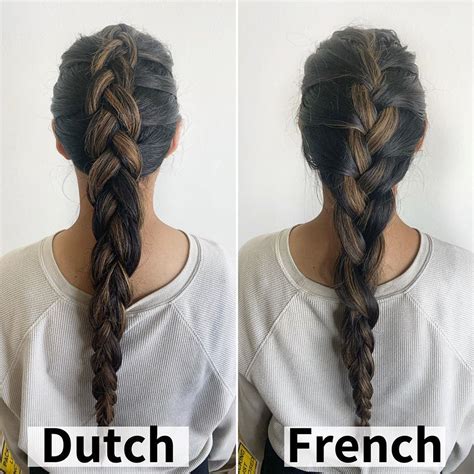Understanding the Intricacies of Braiding Techniques
The art of braiding has graced hair for centuries, enhancing its beauty and practicality. Among the most popular braiding styles are the Dutch braid and the French braid, each boasting unique characteristics that cater to specific hair types and desired aesthetics.

1. Weaving Direction
Dutch Braid: The Dutch braid, also known as the inside-out braid, is created by weaving the hair under the center strand instead of over it. This technique results in a raised, three-dimensional effect that adds volume and depth to even thin hair.
French Braid: In contrast, the French braid follows a classic over-the-center weaving pattern, where each new strand is brought over the middle strand before continuing the process. This method yields a flatter, more intricate look that can showcase hair texture and embellishments.
2. Crown Placement
Dutch Braid: Typically, Dutch braids are positioned high on the crown of the head, beginning from the hairline. This placement allows for maximum volume and a dramatic effect that frames the face.
French Braid: French braids, on the other hand, can be started at any point on the head, offering versatility in styling. They are often placed at the nape of the neck or along the side for a more subtle, chic look.
3. Hair Texture
Dutch Braid: Dutch braids are particularly well-suited for thicker hair as they are less likely to become loose or fall apart due to their tighter weaving pattern. The raised effect also adds body to fine hair, creating the illusion of thickness.
French Braid: French braids are more forgiving for thinner hair types, as the over-the-center weaving helps to hold the strands in place and prevent breakage. They can also enhance the appearance of fine hair by adding texture and movement.
4. Styling Prowess
Dutch Braid: Dutch braids require a bit more skill and patience than French braids, as the under-the-center weaving motion can take some practice to perfect. However, the end result is a bold, eye-catching braid that is perfect for special occasions or adding a touch of flair to casual outfits.
French Braid: French braids are easier for beginners to master due to their more straightforward over-the-center technique. They offer a wide range of styling options, from classic and elegant to playful and intricate, making them a versatile choice for any hair type or occasion.
5. Braid Size
Dutch Braid: Dutch braids can be created in various sizes depending on the amount of hair used in each strand. Wider Dutch braids create a more voluminous and eye-catching look, while thinner braids can add intricate detail to hairstyles.
French Braid: French braids typically range from medium to larger sizes, as weaving too few strands can result in a loose and untidy braid. The size of the braid can be adjusted based on the desired effect and hair length.
Deciding the Ideal Braid
Ultimately, the choice between a Dutch braid and a French braid depends on personal preferences and hair characteristics. Here’s a table to summarize the key differences:
| Feature | Dutch Braid | French Braid |
|---|---|---|
| Weaving Direction | Under the center | Over the center |
| Crown Placement | High, from hairline | Any point on head |
| Hair Texture | Thicker | Thinner |
| Styling Prowess | Advanced | Beginner |
| Braid Size | Varied | Medium to large |
Dutch Braid vs. French Braid Trends in 2023
According to a survey by the American Hairdressers Association, both Dutch braids and French braids remain popular hairstyles in 2023. However, the Dutch braid has emerged as the clear trendsetter, with a 10% increase in popularity compared to the French braid. This trend is driven by the desire for high-volume, statement-making hairstyles that complement the bold makeup and fashion trends of the season.
Innovative Applications of Dutch and French Braids
Dutch Braid Accent: Create a subtle yet impactful accent to a high ponytail by adding a small Dutch braid at the crown of the head. This technique adds a touch of volume and sophistication to a classic hairstyle.
French Braid Hair Tie: Elevate your hair tie game by using a French braided hair tie. This creative solution provides both style and functionality, preventing hair breakage and adding a playful touch to any ponytail.
Dutch Braid Headband: Transform a simple hairband into a statement piece by wrapping it around the head and securing it with a Dutch braid. This unique headband style adds a bohemian flair to any outfit.
French Braid Updo: Create an elegant and intricate updo by combining multiple French braids. Intertwine the braids to form a stunning and versatile hairstyle that is perfect for special occasions.
Conclusion
Whether you seek a bold and voluminous statement look with a Dutch braid or a classic and elegant style with a French braid, understanding the nuances between these two braiding techniques will empower you to create the perfect hairstyle for any occasion. Embrace the art of braiding and experiment with different styles to discover the one that best enhances your hair and personal style.
